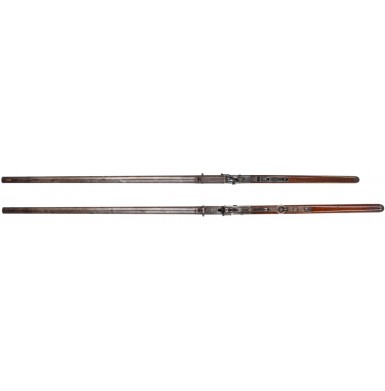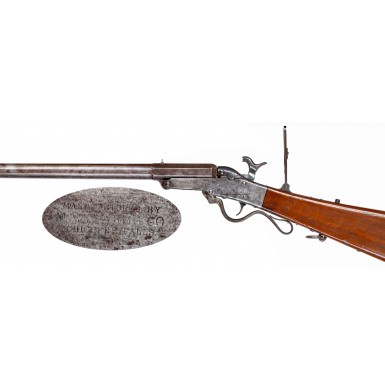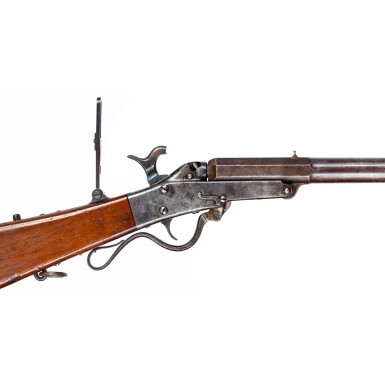1st Model 50 Caliber Maynard Military Rifle Likely Purchased by Mississippi in December 1860
- Product Code: FLA-4049-SOLD
- Availability: Out Of Stock
-
$5,995.00
This is a very crisp example of the scarce and desirable 1st Model Maynard Carbine. It is particularly desirable as it is one of the small number of .50 caliber 26” barreled guns produced with a military frame that was almost certainly purchased by the State of Mississippi immediately prior to the Civil War.
These guns were the invention of famous dental surgeon and firearms innovator Dr. Edward Maynard. Dr. Maynard is probably best known for his invention of the Maynard Tape Priming System, an automated priming system that utilized a varnished strip of laminated paper with small amounts of fulminate of mercury sandwiched between the layers, similar to a modern-day child’s cap gun. The system advanced the roll of primers each time the hammer was cocked, and upon firing, a sharp blade at the rear edge of the hammer’s nose cut off the spent cap. This system showed such promise and was so well thought of by the US Ordnance Department that the US Government paid Maynard $75,000 for the use of his priming system on the US Model 1855 series of arms. In addition to his tape-priming patent (#4,208, issued in 1845), Maynard received a total of 23 US patents related to innovations or improvements to firearms designs.
Maynard’s carbine design was an innovative breech-loading firearm, which used a proprietary brass cartridge with a small flash hole in its base which was loaded with powder and a lubricated bullet, relying upon Maynard’s tape priming system for ignition. In 1853 Maynard paid the Springfield Armory $116.37 to produce a full-scale model of his carbine, and this model was subsequently tested by the Ordnance Department in 1856 with very positive results. The successful trials resulted in the formation of the Massachusetts Arms Company in 1857, which was formed for the purpose of producing Dr. Maynard’s breech loading long arm. The guns were produced in both carbine and rifle lengths, with 20” and 26” barrels respectively, and were offered in both .35 (often misidentified as .36 or .37 caliber) and .50 caliber. They were also offered in both a “sporting” and a “military” configuration. The sporting arms did not include a sling ring on the frame, nor did it include a fixed sight on the barrel. Instead, the gun’s only rear sight was the flip up, adjustable tang sight. The military configuration included a sling ring mounted in the trigger plate to the rear of the operating lever. It also included a fixed, “quick acquisition” rear sight on the barrel, in addition to the adjustable sight on the tang.
The U.S. Army held additional trials of breech loading long arms in 1858, and the ease of operation of Maynard’s design, and its ability to function quickly and reliably, helped to win the Massachusetts Arms Company a contract for 400 of their .50 military pattern carbines. These guns were ordered with fixed sights only (no tang sight) and specified the use of a sling ring on the trigger plate tang, rather than on a traditional sling bar on the side of the carbine. These carbines were delivered in March and April of 1859. In late 1859 the US Revenue Cutter Service ordered an additional 200 Maynard carbines. While the first 100 arms ordered were referred to as “rifles” which suggests the 26” barrel, it is believed that all 200 of these guns were in fact carbines with 20” barrels, chambered for the .50 Maynard cartridge. In February of 1860, the US Navy ordered 50 1st Model Maynard carbines, also in .50 caliber. While the Massachusetts Arms Company pursued what they perceived to be lucrative US government military contracts, they also produced sporting versions of the rifle and carbine and offered them for sale to the general public. The guns were available in both barrel lengths and calibers as well as in cased sets, often with a second barrel, loading tools and a variety of optional accessories.
According to arms researcher, author, and historian James D McAulay, a number of famous (and soon to be famous) Southerners purchased Maynard sporting arms. These men included South Carolina’s Wade Hampton, Georgia senator Robert Toombs and Vice President John Breckenridge of Kentucky; all of whom became Confederate Generals during the American Civil War. The initial production goal of the Massachusetts Arms Company had been 5,000 arms. According to McAulay, as of 1 October 1860 the company had sold approximately 1,400 guns and had a total of 3,527 arms in inventory. The inventory on hand was distributed as follows:
326 2nd Quality Arms in a variety of configurations.
459 .50 caliber with 20” barrels in Sporting Configuration.
676 .50 caliber with 20” barrels in Military Configuration.
142 .50 caliber with 26” barrels in Sporting Configuration.
160 .50 caliber with 26” barrels in Military Configuration.
1,326 .35 caliber with 20” barrels in Sporting Configuration.
425 .35 caliber with 20” barrels in Military Configuration.
13 .35 caliber with 26” barrels in Military Configuration.
McAulay further notes that approximately 90% of this remaining inventory of 1st Model Maynard rifles and carbines were purchased by southern states and militia companies between October 1, 1860, and April of 1861. McAulay’s research indicates that the majority of the guns went to the states of Mississippi, Florida, and Georgia. According to his figures, Florida acquired a total of 1,030 guns in December of 1860. All of these were carbine length with 20” barrels and were chambered in .35 caliber. Mississippi acquired 800 guns in December of 1860 as well. Their purchase included both 20” carbines (625 total) and 26” rifles (175 total) and the guns were a mixture of .50 and .35 caliber, with all 175 of the rifles and 300 of the carbines being .50 caliber and the remaining 325 carbines being .35 caliber. All 650 of the Georgia purchased guns were .50 caliber carbines. While Florida and Mississippi acquired their guns directly from the Massachusetts Arms Company, Georgia purchased their guns in January and March of 1861 from the firm of W.J. Syms & Brothers of New York City. Syms sold an additional 1,700 Maynards between October 1860 and May 1861. It is estimated that all but about 100 of these guns went to southern purchasers. McAulay notes that approximately 800 of these guns also went South Carolina and Louisiana. The balance of the estimated 800 “Confederate” sales by Syms were apparently made to Kentucky and Tennessee in April and May of 1861.
A substantial number of Confederate regiments were at least partially armed with 1st Model Maynard rifles and carbines during the Civil War, resulting in the guns (in both barrel lengths and calibers) being listed in the 1863 Confederate Ordnance Manual as a standard issue Confederate carbine. Some of the Confederate units armed with the guns included the 1st and 6th Florida Special Battalion of Infantry, 2nd Florida Cavalry, 5th & 9th Georgia Cavalry, Cobb’s Legion of Cavalry (Georgia), 1st Louisiana Cavalry, 11th Louisiana Infantry, 1st & 4th Mississippi Cavalry, 9th, 14th & 15thMississippi Infantry, 18th North Carolina Infantry, 3rd Tennessee Cavalry, 35th Virginia Cavalry Battalion and the Waccamaw South Carolina Light Artillery. Some 1st Model Maynards were also issued to the Confederate ironclad CSS Atlanta.
The production of the 1st Model Maynard was brought to an end by a fire at the Massachusetts Arms Company factory in January of 1861. While the fire prevented production of arms for nearly two years, all of the completed arms on hand were saved. Dr. Maynard proceeded to buy out all of the various partners and owners of the company in 1862 and by 1863 the factory was back in business, producing the 2nd Model Maynard Carbine for the US Ordnance Department.
This 1st Model Maynard Rifle is in about VERY GOOD+ overall condition. The gun is a 26” barreled, .50 caliber, military configuration rifle. This makes it one of only 160 military pattern, .50 caliber rifles (26” barrel) on hand at the Massachusetts Arms Company on October 1, 1860. Based upon Confederate purchase records, this gun was almost certainly sold to Mississippi, as that state acquired 175 26” barreled Maynards in .50 caliber. The gun is 100% complete and correct and remains quite crisp, with legible markings throughout. The gun is mechanically excellent and fully functional in every way, including the somewhat temperamental Maynard Tape Priming System, which is fully intact and works perfectly. An open roll of Maynard primers is even located inside the primer magazine of the lock system. The action of the carbine remains crisp and tight, with solid and secure lock up. The carbine is marked in two lines on the lower right side of the frame:
MAYNARD ARMS CO.
WASHINGTON
It is additionally marked on the lower left side of the frame:
MANUFACTURED BY
MASS. ARMS CO.
CHICOPEE FALLS
This marking is somewhat weaker. The patchbox door is crisply stamped in four lines:
MAYNARD PATENTEE
SEP 22 . 1845
MAY 27 . 1851
JUNE 17 . 1856
The inside of the patchbox retains two unopened rolls of Maynard tapes, which appear to have been there since the period use. There is also a very scarce spare percussion cone (nipple) in the patchbox. These proprietary small format nipples are often damaged when these guns are found and original replacement cones regularly sell in the $200 to $300 range, when one can be found on the market.
The carbine is serial number 719 and is clearly marked with that number inside the tape primer door and on the bottom of the barrel, where it is concealed by the frame.
As previously noted, the gun is in lovely, crisp condition and appears to be essentially untouched. The frame retains only the most minute traces of color case hardening, most of which has faded and blended to a mottled silvery gray and brown patina. There is some light peppering and minor pinpricking on the frame and some light pitting around the breech area and near the percussion bolster, all from the caustic mercury in the primer pellets. There are also some small areas of lightly scattered surface roughness and surface oxidation on the frame. The interior of the tape primer compartment is crisp and shows some dully mottled bluish traces of case coloring. The original cone (nipple) is in place, and remains fairly crisp, although it does show some wear and use. The barrel none of its original finish. Like the frame, the barrel has a mostly smoky gray base color with a somewhat mottled plum-brown patina over the metal, mixed with scattered patches of darker age oxidation and a few patches of light surface roughness. There are also some small, scattered patches of minor peppering and pinpricking along the length of the barrel, the most noticeable areas being around the breech and muzzle, as would be expected. The large rounded buttplate and patchbox both have a mixed oxidized brown and pewter gray patina as well, with freckled and oxidized age discoloration over most of their surfaces. The gun is in the “military” configuration and has the original sling ring, secured by the original metal staple on the rear of the trigger plate tang. It also has the standard “military” sight package, which includes the flip up, long-range tang sight, but also a fixed, “quick acquisition” rear sight, on the breech of the barrel. The original adjustable tang sight is in place behind the hammer and the original German silver front sight blade is present on the top of the barrel, near the muzzle. The bore of the carbine is in about VERY GOOD condition. The .50 caliber bore is partly bright and retains fairly good rifling. The bore shows a moderate amount of scattered oxidation and light to moderate pitting evenly distributed along the length of the bore. One of the unique features of the 1st Model Maynard was the ability to adjust the headspace of the gun, by adjusting the relationship between the barrel breech and rear of the frame. This was accomplished by the means of blocking wedges which could be moved slightly by turning two screws located in the bottom of the frame, forward of the trigger guard. The original screws that were used to adjust these blocks remain in place in the frame, and the relationship between the barrel and frame appears to be correctly adjusted. The screw heads of the carbine remain in fairly good condition, with only a couple showing any real slot wear. The buttstock is in about VERY GOOD+ to NEAR FINE condition. The stock is solid and free of any breaks, cracks, or repairs. The buttstock shows the usual assortment of scattered bumps, dings, mars and scuffs from service, handling, and use, but shows no abuse or significant damage. The stock retains some of the original varnish as well.
Overall, this is a very nice, complete, and attractive example of a 1st Model Maynard Rifle. The gun is in fine mechanical condition, has a good bore and is as complete correct and original as one could hope to find. The gun really does qualify as “unmolested and untouched”. The gun is in the desirable .50 military rifle configuration, which suggests that the gun is almost certainly a Confederate purchased arm that went to Mississippi. 1st Model Maynard rifles and carbines do not appear on the market very often, and when they do, they often show significant wear and numerous replacement parts. The primer mechanisms rarely work and the take down pin is almost always a modern replacement. This gun has none of those issues, as it is mechanically perfect and the parts remain original, down to the take down pin and screws. This is a crisp example of a 1st Model Maynard that almost certainly saw Confederate use, which I am sure you will be very happy with and will be proud to add to your collection.
Tags: 1st, Model, 50, Caliber, Maynard, Military, Rifle, Likely, Purchased, by, Mississippi, in, December, 1860












